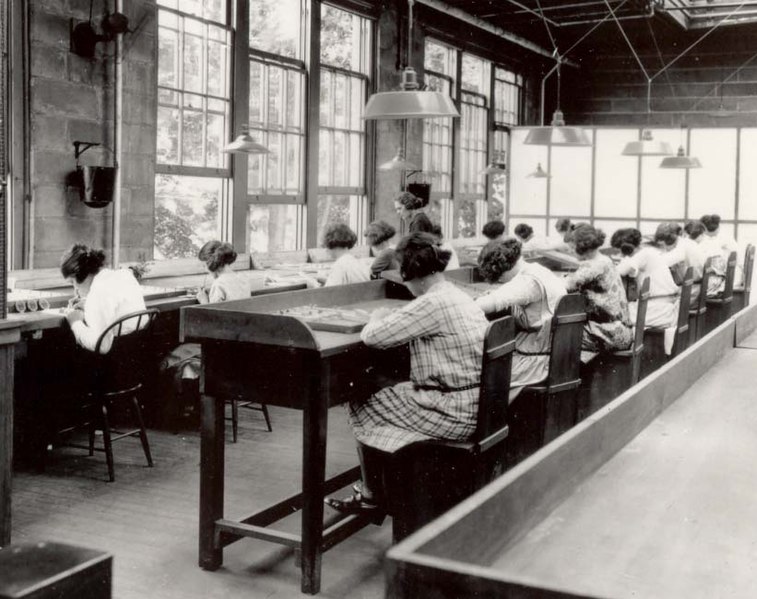358-The Radium Girls
Futility Closet
Greg Ross
4.8 • 748 Ratings
🗓️ 13 September 2021
⏱️ 31 minutes
🧾️ Download transcript
Summary

In 1917, a New Jersey company began hiring young women to paint luminous marks on the faces of watches and clocks. As time went on, they began to exhibit alarming symptoms, and a struggle ensued to establish the cause. In this week's episode of the Futility Closet podcast we'll tell the story of the Radium Girls, a landmark case in labor safety.
We'll also consider some resurrected yeast and puzzle over a posthumous journey.
Intro:
Joseph Underwood was posting phony appeals for money in 1833.
The earliest known written reference to baseball appeared in England.
Sources for our feature on the Radium Girls:
Claudia Clark, Radium Girls : Women and Industrial Health Reform, 1910-1935, 1997.
Ross M. Mullner, Deadly Glow: The Radium Dial Worker Tragedy, 1999.
Robert R. Johnson, Romancing the Atom: Nuclear Infatuation From the Radium Girls to Fukushima, 2012.
Dolly Setton, "The Radium Girls: The Scary but True Story of the Poison that Made People Glow in the Dark," Natural History 129:1 (December 2020/January 2021), 47-47.
Robert D. LaMarsh, "The Radium Girls: The Dark Story of America's Shining Women," Professional Safety 64:2 (February 2019), 47.
Angela N.H. Creager, "Radiation, Cancer, and Mutation in the Atomic Age," Historical Studies in the Natural Sciences 45:1 (February 2015), 14-48.
Robert Souhami, "Claudia Clark, Radium Girls," Medical History 42:4 (1998), 529-530.
Ainissa Ramirez, "A Visit With One of the Last 'Radium Girls,'" MRS Bulletin 44:11 (2019), 903-904.
"Medicine: Radium Women," Time, Aug. 11, 1930.
"Poison Paintbrush," Time, June 4, 1928.
"Workers From Factory May Get Federal Honors," Asbury Park Press, June 27, 2021.
John Williams, "Tell Us 5 Things About Your Book: Kate Moore's 'The Radium Girls,'" New York Times, April 30, 2017.
Jack Brubaker, "Those 'Radium Girls' of Lancaster," [Lancaster, Pa.] Intelligencer Journal / Lancaster New Era, May 9, 2014.
William Yardley, "Mae Keane, Whose Job Brought Radium to Her Lips, Dies at 107," New York Times, March 13, 2014.
Fred Musante, "Residue From Industrial Past Haunts State," New York Times, June 24, 2001.
Denise Grady, "A Glow in the Dark, and a Lesson in Scientific Peril," New York Times, Oct. 6, 1998.
Martha Irvine, "Dark Secrets Come to Light in New History of 'Radium Girls,'" Los Angeles Times, Oct. 4, 1998.
Marc Mappen, "Jerseyana," New York Times, March 10, 1991.
"Radium Poisoning Finally Claims Inventor of Luminous Paint After Fight to Harness Terrific Force of Atom," Brooklyn Daily Eagle, Nov. 25, 1928.
"Two of Women Radium Victims Offer Selves for Test While Alive," [Danville, Va.] Bee, May 29, 1928.
"Death Agony From Radium," [Brisbane, Qld.] Daily Standard, May 15, 1928.
"To Begin Two Suits Against Radium Co.," New York Times, June 24, 1925.
"U.S. Starts Probe of Radium Poison Deaths in Jersey," Brooklyn Daily Eagle, June 19, 1925.
Listener mail:
Carolyn Wilke, "How Do We Know What Ancient People Ate? Their Dirty Dishes," Atlantic, July 24, 2021.
Chris Baraniuk, "The Treasure Inside Beer Lost in a Shipwreck 120 Years Ago," BBC, June 22, 2021.
Fiona Stocker, "A Beer Brewed From an Old Tasmanian Shipwreck," BBC, Dec. 7, 2018.
Mary Esch, "Taste of History: Yeast From 1886 Shipwreck Makes New Brew," AP News, March 15, 2019.
National Collection of Yeast Cultures.
"National Collection of Yeast Cultures," Wikipedia (accessed Aug. 29, 2021).
"History of Missing Linck," Missing Linck Festival (accessed Sep. 3, 2021).
"Missing Linck Festival Arrives … Finally!" The Gnarly Gnome, June 4, 2021.
This week's lateral thinking puzzle was contributed by listener Tim Ellis, who sent this corroborating link (warning -- this spoils the puzzle).
You can listen using the player above, download this episode directly, or subscribe on Google Podcasts, on Apple Podcasts, or via the RSS feed at https://futilitycloset.libsyn.com/rss.
Please consider becoming a patron of Futility Closet -- you can choose the amount you want to pledge, and we've set up some rewards to help thank you for your support. You can also make a one-time donation on the Support Us page of the Futility Closet website.
Many thanks to Doug Ross for the music in this episode.
If you have any questions or comments you can reach us at [email protected]. Thanks for listening!
Transcript
Click on a timestamp to play from that location
| 0:00.0 | Welcome to the Futility Closet Podcast, forgotten stories from the pages of history. |
| 0:15.4 | Visit us online to sample more than 12,000 quirky curiosities from old spam to English baseball. |
| 0:22.7 | This is episode 358. I'm Greg Ross. |
| 0:25.4 | And I'm Sharon Ross. In 1917, a New Jersey company began hiring young women to paint luminous |
| 0:32.2 | marks on the faces of watches and clocks. As time went on, they began to exhibit alarming symptoms and a struggle |
| 0:39.2 | ensued to establish the cause. In today's show, we'll tell the story of the radium girls, |
| 0:45.1 | a landmark case in labor safety. We'll also consider some resurrected yeast and puzzle over a posthumous |
| 0:52.3 | journey. |
| 1:02.9 | And just a quick programming note, we'll be off for the next couple of weeks, |
| 1:06.0 | and we'll be back with a new episode on October 4th. |
| 1:14.5 | In 1917, 15-year-old Catherine Chaube took a job with a new employer in Orange, New Jersey. |
| 1:19.8 | The United States had just entered World War I, and there was a great demand for luminous dials that fighting men could read in the trenches, on aircraft, and on convoy ships. |
| 1:25.6 | Catherine would be painting luminous numbers on watch and clock dials in a dial-painting |
| 1:30.5 | studio for the Radium Luminous Materials Corporation. |
| 1:34.6 | The company had been launched by an Austrian immigrant Sabine von Sassaki, who had worked out |
| 1:39.8 | a formula for a self-luminous paint. |
| 1:42.6 | The paint contained a tiny amount of radium, which released |
| 1:45.8 | alpha particles and stimulated zinc sulfide to luminous. It was cheap to produce, and luminous |
| 1:52.1 | watch dials were quickly becoming a fad. The dial painters were young women, ranging in age from |
| 1:57.9 | their mid-teens to their early 20s. They sat at long tables in a sunny room on the |
| 2:03.0 | second floor of the new company building. One of them said, we were a fine, upstanding bunch of girls, |
| 2:08.5 | even though not many of us had been to high school. We were always neatly dressed in our shirt-waists |
... |
Please login to see the full transcript.
Disclaimer: The podcast and artwork embedded on this page are from Greg Ross, and are the property of its owner and not affiliated with or endorsed by Tapesearch.
Generated transcripts are the property of Greg Ross and are distributed freely under the Fair Use doctrine. Transcripts generated by Tapesearch are not guaranteed to be accurate.
Copyright © Tapesearch 2025.

